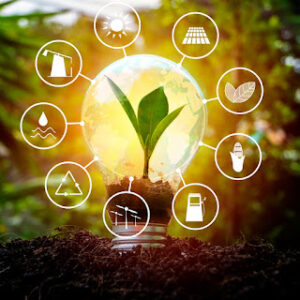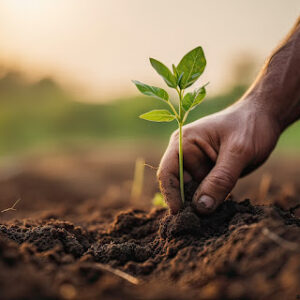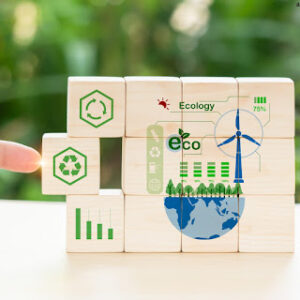
- +254708120315
- vikimsolutions@gmail.com
- Nairobi, Kenya
Climate change is one of the biggest challenges facing the world today, and green buildings have become increasingly important in combating this. These structures take the environment into consideration both in terms of energy and water use through the efficiency of the structures and the use of air as a means of heating, lighting, and cooling with less emissions of pollutants and wastage. When speaking of sustainable development, it is also essential to note that the use of green buildings in urban areas is still possible and plays a large role in the sustainability of a city.
Energy efficiency is perhaps one of the most apparent advantages of green buildings since it describes two of the major goals of these structures. Some aspects of traditional buildings have greatly influenced their energy levels, especially in areas such as heating, cooling, lighting, and appliance usage. These are structures that incorporate modern green products and energy-efficient systems in their construction. Some examples of measures of energy saving include; High Performance Insulation, energy-efficient windows, and LED lighting which will reduce the amount of energy needed by buildings. Also, the increased utilization of generator power and replenishing energy like the utilization of solar panels and wind turbines decreases the use of non-replenishable energy and, therefore, decreases greenhouse gas emissions.
This is a raw issue in most urban centers the world over and thus designing for water has become crucial. This is spanned by green buildings as they incorporate water-efficient fixtures and systems. Some of the techniques used to lower the water consumption within buildings include using low-flow toilets, faucets, and shower heads; rainwater harvesting; and greywater recycling. These measures do not only benefit the natural resources, water specifically but also add to preventing or lessening water stresses on water supply and sewerage systems.
The indoor environment of a building is also an essential component of the building in terms of the productivity and health of the people occupying the building. Green structures should include features that are aimed at improving indoor air quality, free from toxic materials, properly aired, and well lit naturally. The removal of VOCs and other toxic substances in building materials beneficiates occupant’s health, reducing the potential likelihood of developing respiratory diseases and other two or three related ailments common among urban dwellers.
Concrete and waste management activities are some of the activities that contribute to the generation of waste. Green buildings would therefore try to reduce wastage in the construction and use of environment-friendly products that are recycled or naturally sourced. In the construction period too, waste can also be lowered down to its lowest level through proper design that will not require excessive use of materials and through various programs related to recycling of construction waste. After construction has been completed, green buildings also have systems to compost organic waste and other forms of waste and recycle other materials cutting out the damage further.
From the environmental and health aspects, green buildings are characterized by several economic benefits. Energy and water conservation practices result in a reduction of costs for building owners and consumers in terms of bills. Further, they are more costly and experience lower vacant rates since they attract tenants who prioritize environmentally friendly properties. These buildings can also attract one or the other incentives and rebates by the state and the utility companies, easing the initial capital cost. Moreover, they improve in popularity, because they have lower operating costs in the long term compared to traditional buildings.
Industry and increased population density because of the development of buildings can lead to the production of more heat than the surrounding rural areas, a scenario known as the urban heat island. Green buildings can reduce this impact through the use of cool roofs and green roofs which are made from reflective material, therefore minimizing the absorption of heat. Specifically, green roofs make extra insulation, and they also contribute to the minimization of rainwater which happens to be a notable issue regarding urban hydrology. These measures not only enhance the conditions in regard to building inhabitants but also help to decrease the temperature in cities and regions.
Some factors that contribute to the choice of a green building location and planning may affect transportation modes and integration in urban systems. Examples of environmentally friendly buildings which are constructed are located in areas where public transport means are easily accessible hence little use of private cars that cause pollution. They may also contain bicycle storage facilities and power outlets for charging electric cars, which will enhance more environmentally friendly means of transport. Through the provision of incentives for public and non-motorized transport, green building facilitates the reduction of traffic hold-ups in urban areas and enhances the quality of air.
Alternatively, the subjective aspect shows that green buildings can contribute to the enhancement of the well-being of people and increase their sense of belongingness. This has been enabled by the incorporation of social zones in green buildings, such as group gardening, roof decks, and other common zones. These spaces include social areas and are widely applicable as they help enhance the quality of living for people dwelling in structures. However, it is essential to note that sustainable buildings themselves function as knowledge indicators, providing occupants and visitors with awareness about sustainable practices.
In as much as there are gains that come with the construction of green buildings there are hindrances and difficulties which act as impediments to their construction. One of the major challenges that inhibit green building is the fact of increased initial investments in green building technologies and materials. However, since such costs provide satisfactory returns in the long run, it becomes quite a challenge for some developers and property owners to meet them. On the same note, there may be little information on the positive aspects of green buildings among the stakeholders, whereby this this may act as a major challenge to the implementation of green buildings. Some of the issues include; Regulations and policies, this means that in some parts of the world that require elaborate building codes, they are often not so responsive to green building techniques.
Greener practices are a critical tool in the rebuilding of urban societies by responding to the need for better energy management, water use, CO2 emission, quality of air, construction waste, and minimizing the urban heat island effect. It is for this reason that autonomous vehicles are economically advantageous and bear immense social value for societies.




Copyright © 2024 Vikim Solutions. All rights reserved.
107 Responses
гарантия при продаже аккаунтов https://birzha-akkauntov-online.ru/
гарантия при продаже аккаунтов https://marketplace-akkauntov-top.ru
магазин аккаунтов https://magazin-akkauntov-online.ru/
маркетплейс аккаунтов https://ploshadka-prodazha-akkauntov.ru
продать аккаунт услуги по продаже аккаунтов
магазин аккаунтов купить аккаунт
площадка для продажи аккаунтов https://pokupka-akkauntov-online.ru/
Account Sale Account Market
Gaming account marketplace Find Accounts for Sale
Find Accounts for Sale Verified Accounts for Sale
Buy accounts Sell Account
Secure Account Sales Account Trading Platform
Sell Pre-made Account Ready-Made Accounts for Sale
Account Trading Platform Website for Selling Accounts
Buy accounts Gaming account marketplace
Profitable Account Sales Buy Pre-made Account
Account Purchase Account Trading Service
account sale account buying service
database of accounts for sale https://cheapaccountsmarket.com
account selling service account trading platform
buy pre-made account account acquisition
gaming account marketplace account selling service
marketplace for ready-made accounts accounts market
account buying service marketplace for ready-made accounts
accounts market social media account marketplace
account market account trading platform
account marketplace account purchase
website for buying accounts account market
buy pre-made account accounts market
account selling service account marketplace
profitable account sales account exchange service
sell accounts verified accounts for sale
accounts marketplace online account store
sell account sell accounts
account trading platform secure account purchasing platform
account buying platform https://buy-social-accounts.org/
database of accounts for sale account catalog
buy account buy accounts
account sale buy and sell accounts
online account store buy accounts
account trading service account trading platform
buy account buy account
accounts market sell account
account exchange account purchase
account trading platform buy accounts
guaranteed accounts https://accounts-offer.org
buy pre-made account account marketplace
verified accounts for sale https://buy-best-accounts.org
website for selling accounts https://social-accounts-marketplaces.live
account market https://accounts-marketplace.live/
buy accounts https://social-accounts-marketplace.xyz/
verified accounts for sale https://buy-accounts.space
buy and sell accounts buy accounts
account catalog https://buy-accounts.live/
accounts market buy accounts
account purchase https://accounts-marketplace.online
account marketplace https://accounts-marketplace-best.pro/
маркетплейс аккаунтов соцсетей https://akkaunty-na-prodazhu.pro
маркетплейс аккаунтов rynok-akkauntov.top
продать аккаунт https://kupit-akkaunt.xyz/
продажа аккаунтов akkaunt-magazin.online
площадка для продажи аккаунтов https://akkaunty-market.live/
купить аккаунт https://kupit-akkaunty-market.xyz
покупка аккаунтов https://akkaunty-optom.live
маркетплейс аккаунтов https://online-akkaunty-magazin.xyz
маркетплейс аккаунтов соцсетей https://akkaunty-dlya-prodazhi.pro
маркетплейс аккаунтов https://kupit-akkaunt.online/
buy a facebook account https://buy-adsaccounts.work
buy account facebook ads buy-ad-accounts.click
buy accounts facebook https://buy-ad-account.top
buy fb ads account buy-ads-account.click
buy accounts facebook https://ad-account-buy.top
buy facebook old accounts https://buy-ads-account.work
facebook ad account buy https://ad-account-for-sale.top
facebook ad accounts for sale https://buy-ad-account.click
buy aged facebook ads account https://ad-accounts-for-sale.work
google ads agency account buy buy google ads accounts
google ads agency accounts https://buy-ads-accounts.click
facebook ad account for sale buy facebook account for ads
google ads accounts https://ads-account-for-sale.top
sell google ads account https://ads-account-buy.work
sell google ads account https://buy-ads-invoice-account.top
old google ads account for sale https://buy-account-ads.work
buy google ads verified account https://buy-ads-agency-account.top
google ads account seller https://sell-ads-account.click
buy google ads agency account https://ads-agency-account-buy.click/
facebook bm account buy buy facebook bm account
buy google ads agency account buy google ads verified account
buy facebook business manager https://buy-bm-account.org
buy facebook bm account https://buy-business-manager-acc.org/
buy verified facebook business manager account buy-verified-business-manager-account.org
verified business manager for sale buy-verified-business-manager.org
buy facebook bm buy business manager account
buy facebook ads accounts and business managers buy-business-manager-verified.org
buy bm facebook verified bm
buy bm facebook verified-business-manager-for-sale.org
buy facebook business account buy verified facebook business manager account
buy tiktok ads account https://buy-tiktok-ads-account.org
tiktok ad accounts tiktok ads account buy
buy tiktok ads buy tiktok ads
tiktok agency account for sale buy tiktok ad account
tiktok agency account for sale https://buy-tiktok-ad-account.org
tiktok agency account for sale https://buy-tiktok-ads-accounts.org
buy tiktok ads account https://tiktok-ads-agency-account.org
buy tiktok business account https://buy-tiktok-business-account.org
buy tiktok ads https://buy-tiktok-ads.org
Thank you for your sharing. I am worried that I lack creative ideas. It is your article that makes me full of hope. Thank you. But, I have a question, can you help me?